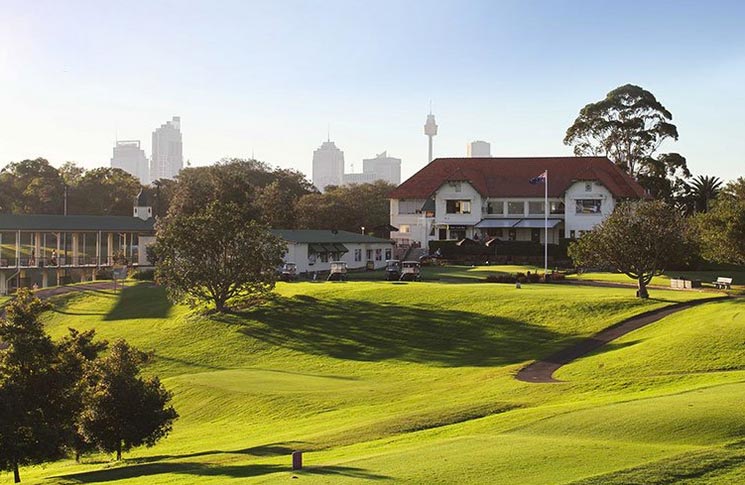From New Zealand’s alpine escape of Queenstown to Sydney’s leafy northern suburbs, residential-golf developments continue to drive course construction and refurbishment.
Queenstwon is the unlikeliest of settings for the residential-golf trend that is driving golf-course construction in New Zealand. The alpine escape is better known for adventure tourism and the white-knuckle pursuits of skiing, white-water rafting and bungee jumping.
Nestled among a mountainous backdrop with mean winter daily maximums of 8°C (June and July), Queenstown has blossomed into one of the southern hemisphere’s finest golf destinations with a variety of fun courses. The most accessible of which are the public-access, residential-golf developments at Millbrook Resort, Jack’s Point and the soon-to-be-opened Glendhu.
And the man who has virtually single-handedly turned Queenstown into a fashionable golf destination is course architect John Darby.
“It can’t be a coincidence that John Darby has been involved with every successful residential-golf development in New Zealand,” says Ryan Brandeburg, executive director of Golf Tourism New Zealand. “His ongoing work at Jack’s Point, and the new project at Glendhu, continue to show John’s ability to think big.”
Residential-golf developments are driving course construction in New Zealand – unless the developer is a wealthy individual owner who can build without needing to sell real estate to raise the capital. According to Brandeburg: “It’s really the only affordable way to build golf nowadays unless you are independently wealthy.”
After studying landscape architecture at Lincoln University near Christchurch, Darby migrated to Queenstown in 1980, aged 22, when the avid skiier had an inclination towards mountain-resort planning. However, in the mid-1980s after Queenstown suffered lean snow years, Darby started to get a little concerned for the snowsport industry that had recently built the Remarkables Ski Area.
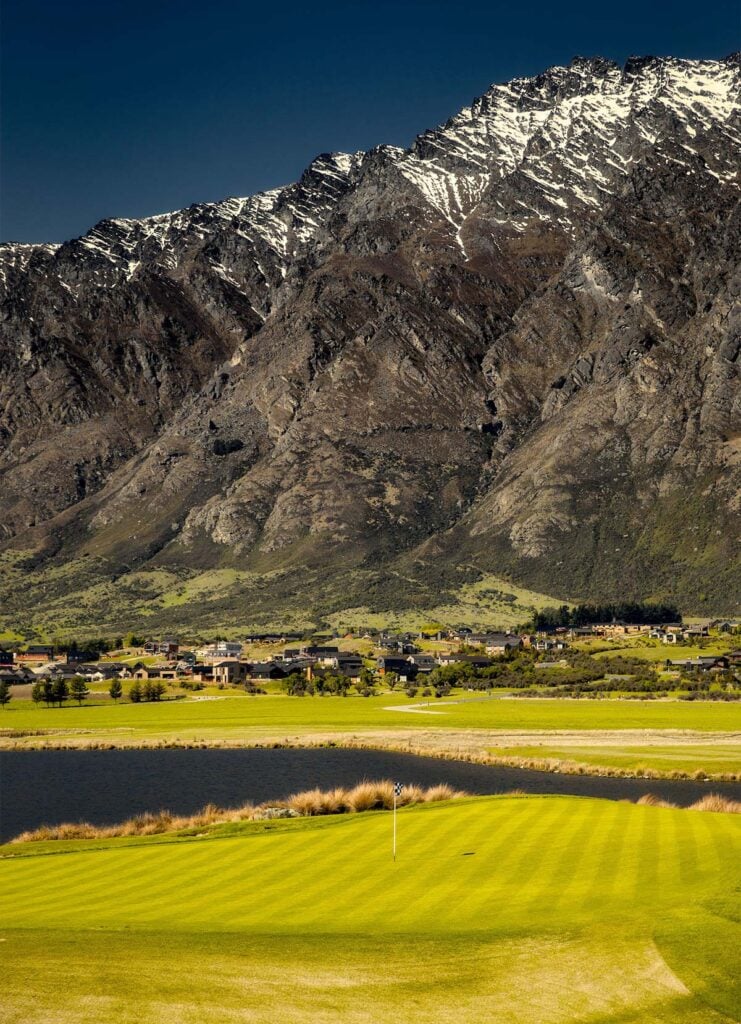
A ‘sliding doors moment’ occurred when Darby was approached to work with the Arnold Palmer Design Company, which had been retained by developers to build a golf course across Lake Wakatipu at Walter Peak. Darby worked with Palmer’s chief designer Ed Seay on the development masterplan, which inspired him to become involved in golf architecture.
While the Walter Peak project was abandoned after the 1987 stock market crash, it triggered Darby’s interest in golf. He collaborated with Sir Bob Charles during the construction of Millbrook after the Queenstown property came up for sale. Then in his mid-30s, Darby pursued golf-specific study at Harvard University and managed to obtain ‘internships’ in the offices of Palmer, Jack Nicklaus and Gary Player.
“So a pretty unique opportunity to get some insights,” Darby recalls. “Because in those days, golf design was very much led by associations with great professionals… It was [fascinating] watching Jack scribble over plans of golf holes.”
Darby has been involved in a variety of golf projects: Millbrook (Queenstown, opened 1992), one of the first golf courses in China for the People’s Liberation Army (Beijing, 1993), Omaha Beach (Northland, 1996), Formosa (Auckland, 1997), Clearwater (Christchurch, 2000), The Hills (Queenstown, 2007), and Jack’s Point (Queenstown, 2008). Incidentally, since 1998, Darby’s championship courses – Formosa, The Hills, Clearwater and Millbrook – have hosted the New Zealand Open on 16 occasions.
For the past decade Darby has been busy at Tara Iti and Te Arai with the construction of three world-renowned courses at Mangawhai, north of Auckland. His involvement traces back to 2005 and a partnership with the local Māori tribe, which acquired settlement of the land as part of a grievance outcome. On the sandbelt location, Darby proposed a network of golf courses with some residential development. A portion of the land was later sold to American Ric Kayne who would develop Tara Iti, designed by Tom Doak. Darby stayed on to facilitate the residential masterplan for the adjacent 36 holes at Te Arai (Doak and Bill Coore).
Jack’s Point: One of the world’s finest lifestyle estates
However, it’s Darby’s role in transforming the alpine escape of Queenstown into a golf destination for which the 68-year-old is best known. Beginning with Millbrook, followed by The Hills for jeweller Michael Hill and then the highly acclaimed Jack’s Point.
From a residential-golf perspective, Millbrook has proven to be a huge commercial success. The developers were smart with bringing lots to market. They would essentially drip-feed lots and the demand was high.
“It was high-risk in the early days,” Darby reflects about Millbrook. “No one had really done a golf resort before in New Zealand – of the scale or purpose. In the late 1980s we were sufficiently young and naive not to stress about the risks of the whole venture. We had good Japanese partners.
“Looking back, we had no idea this would drive visitation and successful hotel and real-estate outcomes. Plus, environmentally, it was a good use of land.”
The residential-golf phenomenon in New Zealand had its origins at the Gulf Harbour golf course on the Whangaparaoa Peninsula on Auckland’s northern outskirts. Gulf Harbour is considered a failed exercise. It came to market with no design controls – think pink stucco house next to a stylish, modern, glass mansion next to a wooden shingle. It was a coterie of dwellings that didn’t add to the amenity.
Whereas the residential-golf community at Jack’s Point has been recognised as one of the world’s top-10 lifestyle estates (New World Wealth). Jack’s Point has a central village with five distinctive precincts and eight residential neighbourhoods surrounding a world-class, 18-hole layout. The development will comprise about 2,500 homes and some 8,000 residents once complete. While the first homesites were priced from $NZ250,000, they are now selling for more than $NZ1 million.
Jack’s Point is remarkable for comprehensive master-planning. It has successfully harnessed the best land for golf and the best land for development, so as they don’t conflict with each other. Darby Partners, with about 15 core staff, has a reputation for carefully managing large areas of sensitive landscape and lakefront land for an outcome that integrates a limited amount of housing. Wayuna at the Jack’s Point preserve would be regarded as a project that follows this formula of protecting significant areas of open space.
Darby’s latest project, Glendhu on Lake Wanaka, is a “beautiful property and the one that I’ve been waiting 20 years to action because it’s so special”. Glendhu has been a labour of love, such has been the exhausting environmental hurdles that would’ve deterred many a course architect. At what Darby calls his “happy place”, the public-access Glendhu is anticipated to open for play by mid-2026.
Elsewhere in Queenstown, construction is almost complete at the nine-hole course at Gibbston Valley Resort, designed by former tour professional Greg Turner. Gibbston Valley is part of a $750 million residential-golf development by Greg Hunt, chief executive of the Central Otago winery of the same name that is located next door. The estate and course feature dramatic river gorge and mountain views as well as gold miners’ tailings and large rocks that remove the need for bunkering.
• • •
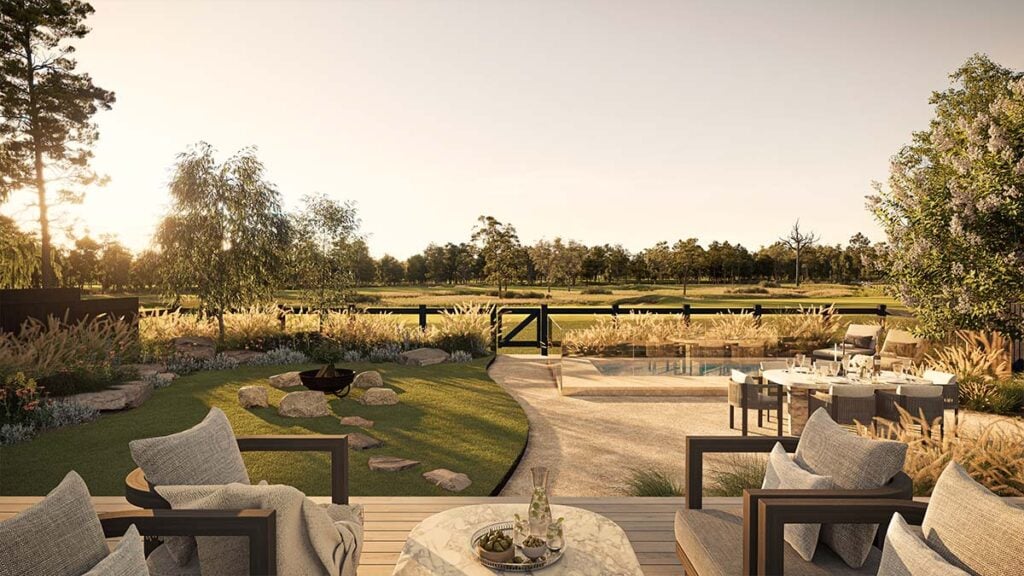
Regional Australia is witnessing a mix of large-scale and boutique residential-golf developments. In the New South Wales Lower Hunter Valley, the Lovedale Farm project is accelerating at pace after laying idle for many years. Capital Corporation has been granted planning approval for a 500-lot community with further scope for apartments plus a resort around an 18-hole, championship-length golf course designed by Darius Oliver.
Just two hours’ drive from Sydney, the 240-hectare Lovedale Farm development is literally across the road from The Vintage residential-golf estate and the two properties will eventually share a roundabout on Wine Country Drive.
In March, Capital Corporation released two options for buyers: designer homes and lifestyle land. The custom-range designer homes offer a complete house-and-land package with landscaping, fencing and driveway. Village designer homes range from $1.3 million to $1.7 million; fairway designer homes from $1.8m–$2.5m; and lifestyle designer homes $1.7m–$2.1m. Approximately 70 percent of stock has sold in the project’s first-stage release of designer homes, totalling a combined value of $55 million. They are due for completion in 2027.
For buyers wishing to design and build their own home, they may choose from blocks with golf-course frontage, village precinct and larger lifestyle land – generous lots ranging from 1,100sqm to 3,000sqm and priced from $995,000.
Lovedale Farm is anticipated to reach maturity in eight to 10 years. Capital Corporation director Jim Hunter says the everlasting appeal will centre on the resident facilities – from the clubhouse and food-and-beverage precinct, to the 18-hole golf course and recreational areas.
“Nowhere else in the country is actually pulling all these pieces of the puzzle together and putting it into a single destination that’s two hours from Sydney, one hour from Newcastle and in the heart of Australia’s oldest wine region, which is the Hunter Valley,” Hunter says. “It’s the combination of all those key ingredients that makes this truly a landmark project and a landmark place that’s going to live well beyond our lifespan.”
• • •
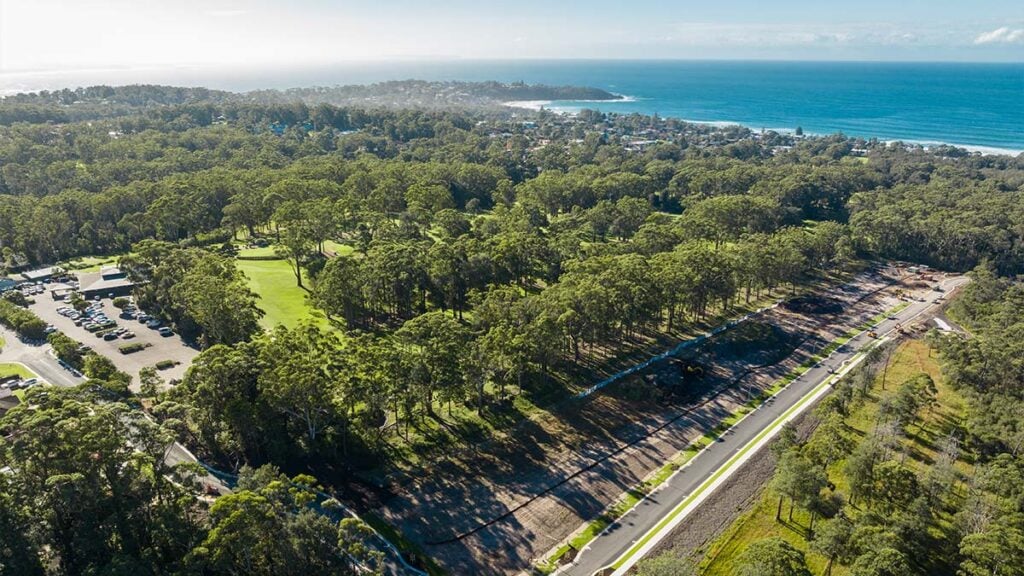
On the New South Wales South Coast, a rare opportunity beckons to live alongside one of the country’s finest rural golf courses. Just two-and-a-half hours from Sydney, Maisie Way estate has 24 boutique lots all backing onto Mollymook Golf Club’s Hilltop layout that’s ranked 82nd on Australia’s Top 100 Golf Courses.
Developed by Hazcorp as part of Cameron Brae Group, the exclusive land release is offering generous 702sqm blocks. Nine lots have sold already and the remaining 15 blocks range in price from $825,000 to $985,000. House-and-land packages start from $1,972,577 for a two-storey, four-bedroom dwelling.
All 24 lots have a northerly aspect at the rear, which overlooks the eighth fairway of Mollymook’s championship layout. Mollymook Beach is just 1.3 kilometres away – even shorter if cutting across the golf course.
“There’s nothing else that’s going to come up on the golf course at Mollymook anytime in the future,” says Raine & Horne Mollymook Milton principal/director Ben Pryde, who says most interest has come from outside the area – further up the coast to Sydney and inland to Canberra.
“Everybody that’s purchased a block is looking at spending pretty significant money on a very smart, substantial home. A couple of the serious golfers are talking about having golf simulators and cart access onto the course.”
The triumvirate location of Mollymook/Milton/Ulladulla has boomed over the past decade. The beachside haven has been popularised by celebrity chef Rick Stein, whose Bannisters Restaurant has highlighted the region’s seafood and local produce as well as the café/restaurant scene.
Settlement and registration at Maisie Way are expected in August or September. Further lots without golf-course frontage are planned for release at a later stage (maisiewaymollymook.com.au).
• • •
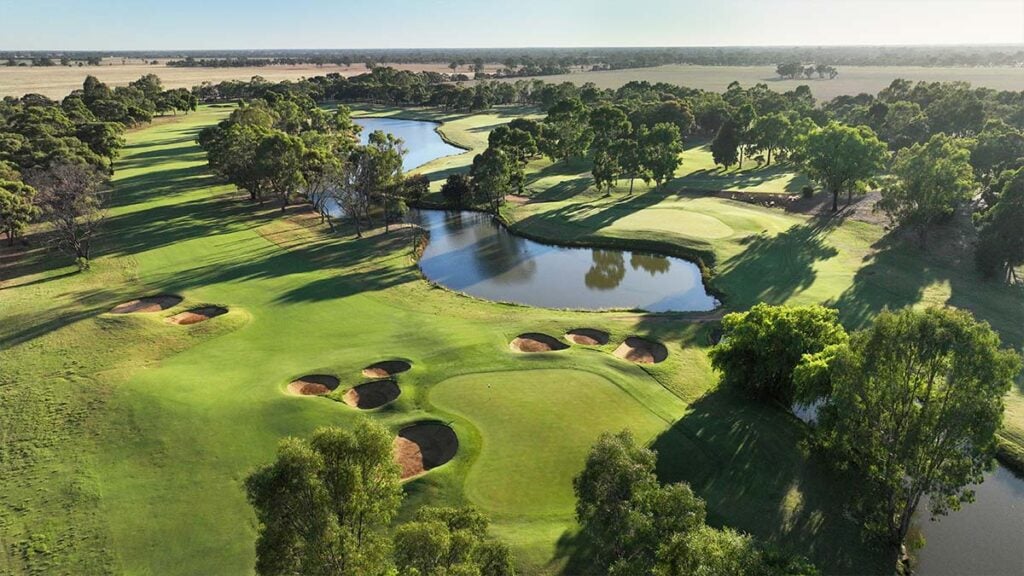
On the Murray River, The Golf Club Estate at Rich River is a boutique community in the twin towns of Echuca (Victoria) and Moama (NSW), once Australia’s largest inland port in the 1800s. Just two-and-a-half hours north of Melbourne, the 51-lot estate is located within the grounds of the 36-hole facility at Rich River Golf Club.
Homeowners have views over the East course, which hosted the 2023 NSW Open. Remaining blocks vary in size from 451sqm to 498sqm. Prices range from $255,000 to $270,000. The estate is a short stroll to Rich River’s multi-functional clubhouse where three lawn bowling rinks, tennis/pickleball courts and a croquet court await.
Homeowners Michael and Karen Mahady have enjoyed a seamless transition since building their home in The Golf Club Estate at Rich River.
“Karen and I are both keen golfers and always had a dream of living on a golf course,” Michael says. “Generally, you understand you will be living around like-minded people with our chosen sport on the doorstep. Karen and I are genuinely loving living here.
“Be ready to be as active or inactive as you wish with a host of sports outside golf to be enjoyed within the greater golf-course boundaries.”
• • •
On the eastern stretch of the Murray River, Yarrawonga is one of the fastest-growing regional towns in Australia. Silverwoods residential golf estate has about 30 blocks remaining from the 900-lot community developed by Lotus Living where Black Bull Golf Course is the focal point.
Eight allotments are currently listed for sale at Silverwoods. The smallest at 399sqm is selling for $318,000, which includes a $20,000 rebate for landscaping. The largest block of 858sqm has golf-course frontage and is priced at $488,000 (with a $30,000 rebate).
“We’re not the little sleepy hollow that we used to be of about 8,000 people. Now it’s probably closer to 15,000 to 20,000 people. So it’s growing,” says local PGA professional James McCully.
“People are opting for a ‘river change’, is what we tend to refer to it as. Not a ‘sea change’ in heading inland… The average house these days in Yarrawonga, probably between $800,000 to $1 million is your starting point.”
• • •
Meanwhile, the golf-course living phenomenon continues to morph in Australia’s capital cities where metropolitan golf clubs are increasingly seeking to revitalise existing assets. The long-term future of Cumberland Country Golf Club at Greystanes in Sydney’s west has been secured with development approval granted for a retirement-living community. Developer Pariter will deliver 234 independent living units, a care hub and a new clubhouse at a capital investment value of $160 million.
The development will comprise six residential buildings between five and seven storeys. It will also include a three-storey care hub with 38 beds. The existing Cumberland clubhouse will be replaced with a new three-storey building that includes a café, lounge, dining areas, gaming rooms and pro shop.
Understandably, the 80-year-old Cumberland club was delighted with the outcome that has taken several years to be approved by the NSW Department of Planning, Housing and Infrastructure. Its ageing facilities required substantial investment and Pariter provided a workable solution.
“This partnership is about preserving the spirit of our club while opening the door to new opportunities,” says Cumberland president Denis Clifford. “It secures a strong future for Cumberland Country Golf Club and ensures our legacy continues to serve not only our members, but also a new generation of residents who share our passion for community and healthy, active living.”
Pariter was equally pleased with the outcome that will create as many as 190 construction jobs and 80 new operational jobs. “This is more than just a development – it’s a shared commitment to delivering quality, wellness-focused living that enhances the legacy of Cumberland Country Golf Club,” says Pariter development director Vanessa Hammer.
The 18-hole golf course will be reconfigured by leading architect Bob Harrison to accommodate the development that occupies 3.8 hectares on the northern portion of Cumberland’s 38-hectare property. The brief was “to do as little as possible to allow for the development to go ahead”.
Cumberland’s first hole will be lost for the residential component, while the layout will change from a par 72 to a par 70. The existing par-5 18th hole will be converted to a par 4 and a par 3 over water, which should captivate onlookers in the new clubhouse. The projected six-month reconfiguration of the course was set to begin at the time of publication. Members will play purpose-built temporary greens and a full 18 holes during the staged build.
“From a members’ perspective, [the message] was along the lines of, ‘When you see a machine out on the golf course, three years later I’m turning a key in the new clubhouse,” says Cumberland chief executive officer Andrew Laplain.
Apart from new amenities, Cumberland will receive an “ongoing deferred management fee” from ongoing sales of the independent living units. It is leasing the land to Pariter over a 99-year period.
• • •
Oatlands Golf Club in Sydney’s north-west has entered a joint venture with Levande to redevelop its clubhouse precinct to include an over-55s residential village. Planning approval has been granted to build 127 seniors living apartments and 13 townhouses.
In exchange, Oatlands receives a new clubhouse with lounge and central bar, restaurant, golf shop, café, gymnasium, locker rooms, club storage area and administrative offices. The club will retain several apartments in the residential development and rental income from these assets will be an ongoing source of revenue.
The Levande proposal requires demolition of the existing clubhouse and carpark precinct to allow for construction of the new clubhouse, underground car parking and the seniors living complex. The existing Oatlands golf course (5,748 metres, par 70) will need minor alterations to accommodate the development.
Oatlands has an ageing one-storey clubhouse with several aspects in need of significant investment. The club opted to seek a development partner to assist in this regard, says Oatlands president Colin McRae: “We’re excited to partner with Levande on a project that will deliver members a world-class clubhouse and facilities, and secure the long-term prosperity of Oatlands Golf Club for future generations.”
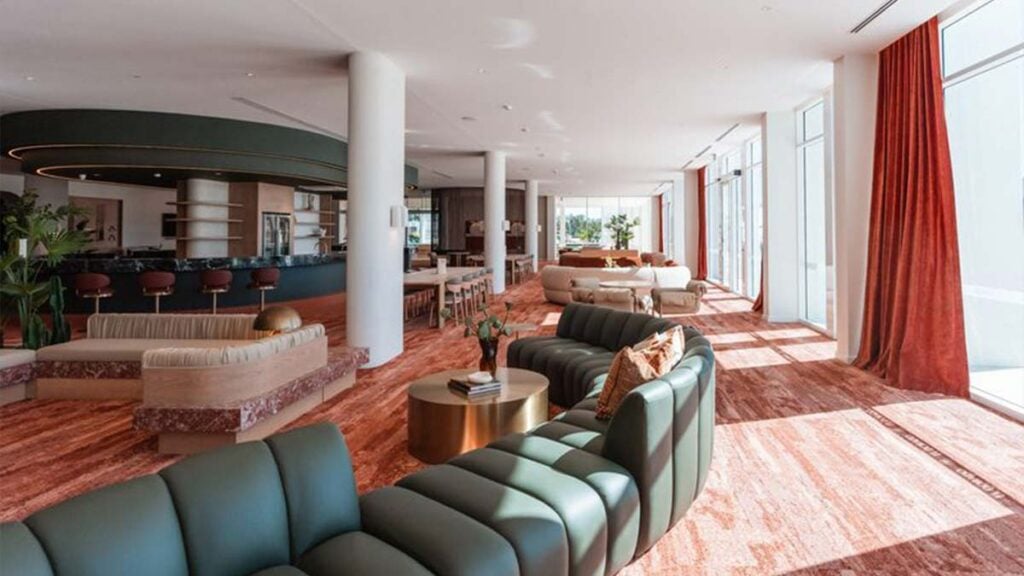
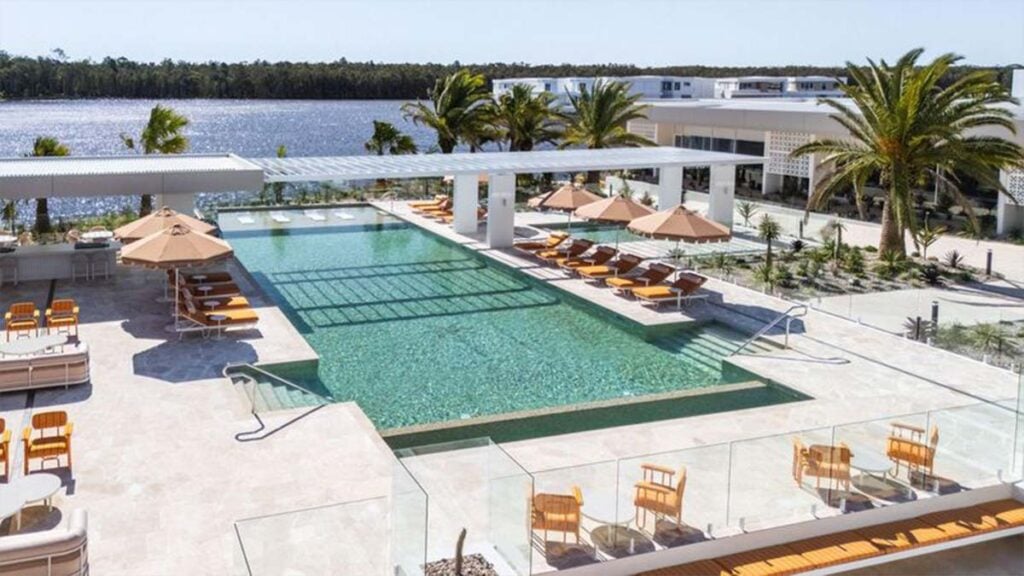
Palm Lake Resort Pelican Waters
A lavish, 11,000sqm country club is set to become one of Queensland’s most sought-after playgrounds for modern over-50s after its opening on Queensland’s Sunshine Coast.
The Springs Country Club at Palm Lake Resort Pelican Waters is a $55 million lifestyle jewel, breaking construction records.
Among the features within this striking architectural masterpiece, The Springs Country Club offers the largest over-50s wellness centre in the southern hemisphere, a championship eight-rink private bowling green, Palm Springs-inspired pool deck, whisky bar, piano bar, tenpin bowling, gold-class movie theatre, elegant social spaces, creative hobby rooms and more.
Not only do Palm Lake Resort Pelican Waters homeowners get to enjoy The Springs Country Club as an exclusive extension of their stylish residences, the community benefits from its enviable position alongside Pelican Waters Golf Course, designed by the Greg Norman Golf Course Design team. In fact, homeowners can enjoy golf course frontage positions, waterfront locations and some prestige homesites offer both.
As part of a Palm Lake Resort Pelican Waters new-home purchase, a complimentary golf cart will be sitting in the driveway, with dedicated golf cart parking featured in every floorplan. Homeowners also receive two years’ access to the award-winning neighbouring golf course as a one-off ‘welcome home’ gift from the developer.
Palm Lake Resort general manager of sales Alysia Nechvoglod says there’s nothing like The Springs Country Club anywhere in Australia.
“We wanted to present something truly outstanding and memorable in the over-50s space and we have done just that,” Nechvoglod says. “We’re constantly told The Springs Country Club is more akin to a six-star international hotel experience. It’s literally breathtaking.”
Palm Lake Resort is a Gold Coast-based, private family company that’s been designing, constructing and operating over-50s lifestyle communities along Australia’s east coast since 1977.
Book a private tour of The Springs Country Club and the display residences on 1800 490 626, or
visit palmlakeresort.com.au


